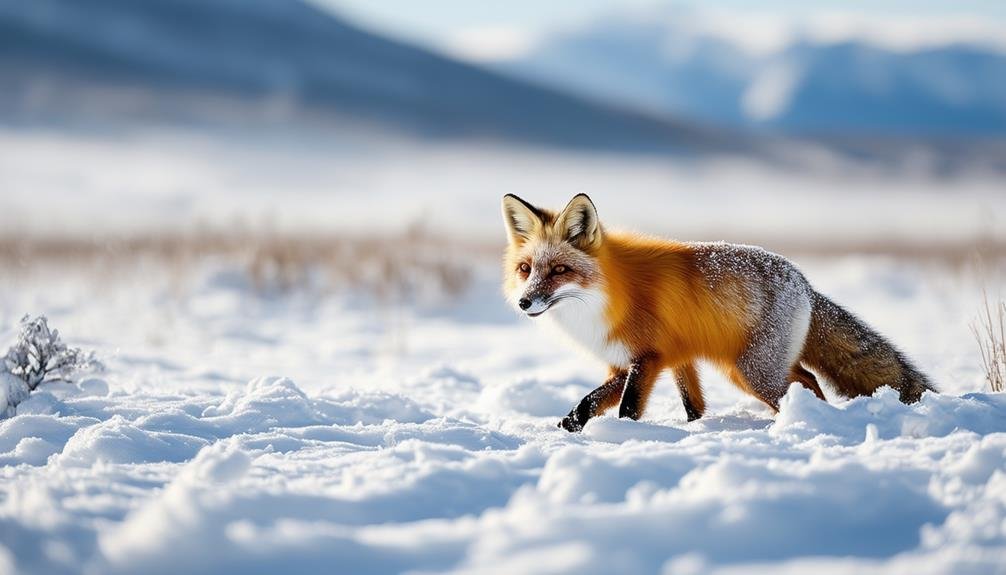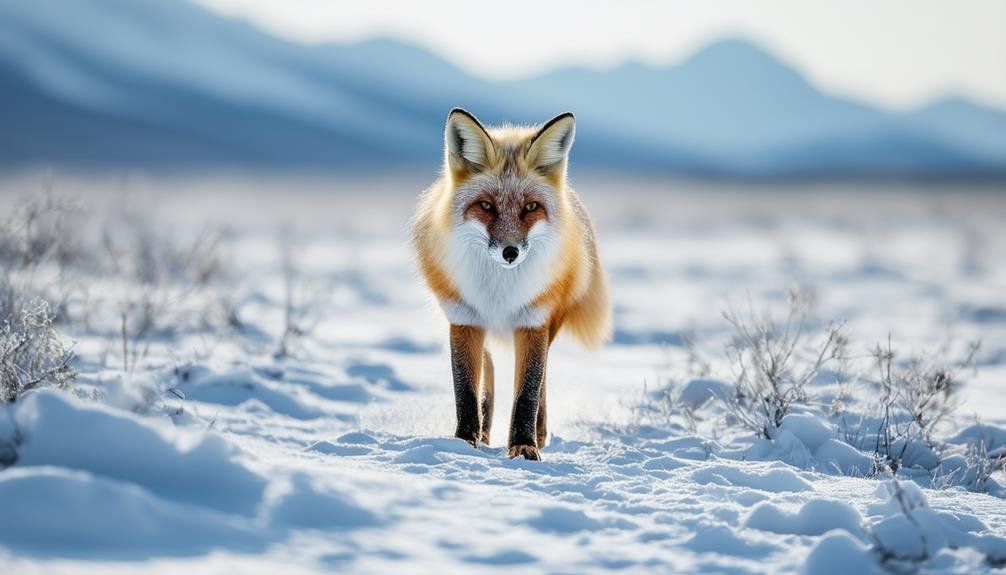Arctic fox adaptations are crucial for survival in the tundra's extreme conditions. Their compact body, small ears, and thick fur effectively conserve heat, while seasonal fur color changes provide camouflage. Acute senses and agile hunting techniques enable successful prey capture, vital in the sparse environment. Reproductive strategies, like raising large litters in underground dens, guarantee offspring survival. Opportunistic feeding and food storage help them endure periods without food. These adaptations allow Arctic foxes to thrive in the harsh tundra where resources are scarce and temperatures can plummet, which showcases their incredible resilience and evolutionary skill. Learn more about their adaptive strategies next.
Main Points
- Arctic foxes' thick fur provides critical insulation against extreme cold.
- Seasonal fur color changes offer effective camouflage for hunting and protection.
- Compact body shape and small ears reduce heat loss in freezing environments.
- Acute senses and agile hunting techniques ensure successful prey capture for survival.
- Monogamous pairs and large litters ensure species continuity in harsh tundra conditions.
Physical Characteristics
The Arctic fox's compact body, small rounded ears, and thick insulated fur are key physical characteristics that minimize heat loss in the tundra. These adaptations are crucial for surviving the extreme conditions of their Arctic habitat. The compact bodies of Arctic foxes reduce the surface area exposed to the cold, thereby conserving heat. Their small, rounded ears further contribute to minimizing heat loss by reducing the area susceptible to freezing temperatures.
The thick insulated fur of the Arctic fox is among its most essential features, providing excellent protection against the harsh, subzero temperatures typical of the tundra. This dense fur covers the entire body, including the paws, which helps to reduce heat loss from the ground. Additionally, the Arctic foxes possess a thick, bushy tail that serves a dual purpose: aiding in balance and acting as an extra layer of insulation when wrapped around their noses during rest periods.
With an average body length of 0.76-1 meter and a weight range of 2.9-5 kilograms, Arctic foxes are well-proportioned for their demanding environment. These physical characteristics collectively equip the Arctic fox to thrive in one of the planet's most unforgiving climates.
Seasonal Fur Changes
Beyond their physical characteristics, Arctic foxes exhibit remarkable adaptability through seasonal fur changes, which serve as an important mechanism for survival in their variable tundra environment. These seasonal fur changes provide multiple benefits essential for thriving in the harsh Arctic conditions.
Firstly, the fur color adaptation allows Arctic foxes to blend seamlessly into their surroundings throughout the year. In winter, their fur turns white, providing effective camouflage against the snow-covered landscape, which is pivotal for both hunting prey and evading predators. In summer, their fur changes to brown or gray, matching the tundra habitat's thawing and vegetative state.
Secondly, the white fur insulation is crucial for surviving extreme cold temperatures during the winter months. The dense, white fur traps heat and provides necessary warmth, ensuring that the Arctic foxes can maintain their body temperature even in the most frigid conditions.
Lastly, the thinner summer coat aids in temperature regulation during warmer months. As the tundra habitat warms, this lighter coat prevents overheating and allows the foxes to remain active and agile.
Hunting Techniques

Arctic foxes demonstrate remarkable hunting techniques by leveraging their acute senses of smell and hearing to locate small mammals beneath the snow-covered tundra. These expert hunters primarily target lemmings and voles, their primary prey in this harsh environment. By listening intently for subtle movements under the snow, Arctic foxes can pinpoint the exact location of their potential meal. Once the prey is detected, they execute a swift and precise dive, plunging nose-first into the snow to capture it.
In addition to their keen senses, Arctic foxes display adaptability in their hunting strategies to survive the extreme conditions of the tundra. They are agile and persistent, which allows them to efficiently track and capture prey even in challenging circumstances. Moreover, when small mammals are scarce, Arctic foxes exhibit opportunistic feeding behaviors by scavenging on carcasses and leftovers from larger predators, such as polar bears.
These hunting techniques are essential for their survival, showcasing the Arctic foxes' ability to thrive in the tundra. Their adeptness at locating and capturing prey ensures they can sustain themselves despite the unforgiving climate, highlighting the critical role of these adaptations in their overall survival strategy.
Reproduction and Family Life
In addition to their adept hunting techniques, Arctic foxes exhibit fascinating reproductive and family dynamics that contribute to their survival in the tundra. These creatures are monogamous and form family groups that often include multiple generations, emphasizing the importance of family unity in their harsh environment.
Female Arctic foxes give birth to large litters, sometimes up to 14 pups, each spring in underground dens. These dens provide crucial shelter and protection from the elements and predators. The following points highlight key aspects of their family life:
- Parental Guidance: Both parents are actively involved in caring for and protecting the pups. This collaborative approach ensures that the young foxes are well-fed, safe, and nurtured.
- Survival Skills: From a young age, the pups are taught critical hunting and survival skills by their parents, which are essential for their future independence.
- Family Cohesion: The strong bonds within the family group enhance the chances of the young foxes reaching independence by the end of summer, ready to face the challenges of the tundra on their own.
These reproductive strategies and family dynamics are crucial for the continuation and resilience of Arctic fox populations in their extreme habitat.
Habitat and Range

Situated in the harsh and frigid environments of North America, Europe, and Asia, Arctic foxes have developed remarkable adaptations that allow them to thrive in the tundra. These foxes inhabit the Arctic tundra, a region characterized by its extreme cold temperatures and sparse vegetation. Significantly, Arctic foxes are also found in coastal areas, where their resourcefulness is further tested by the harsh climatic conditions.
The adaptations of Arctic foxes are critical for their survival in these severe habitats. Their thick, camouflaged fur provides insulation against the cold while also serving as an effective disguise amidst the snowy landscape. This fur changes color with the seasons, turning white in winter and brown in summer, enhancing their ability to blend into their environment.
Their range extends across the tundra and coastal regions, where they build dens for shelter and raising their young. These dens, often constructed in sandy or gravelly soil, offer protection from predators and harsh weather. Additionally, Arctic foxes are proficient swimmers, an adaptation that allows them to navigate between fragmented coastal habitats. Their ability to endure such extreme conditions underscores the importance of their unique adaptations for survival in the Arctic tundra.
Which Key Arctic Fox Adaptations Are Crucial for Survival in the Tundra?
The key arctic fox tundra adaptations include their thick fur, which changes color for camouflage, excellent heat retention, and compact body shape. They possess the ability to store fat for energy during scarce food availability, which helps them thrive in the extreme cold and harsh conditions of the tundra.
Conservation and Threats
Conservation efforts are increasingly essential as climate change and habitat encroachment by red foxes threaten the survival of Arctic foxes in their tundra environment. These animals have evolved a range of adaptations to thrive in harsh conditions, such as their thick fur, compact bodies, and small extremities, which minimize heat loss. However, these specialized traits are under threat from both natural and anthropogenic factors.
Climate Change: Rising temperatures are altering the tundra habitat, reducing the availability of prey and changing snow cover patterns. These changes impair the Arctic fox's ability to camouflage and hunt efficiently, directly impacting their survival.
Habitat Encroachment: The red fox, a larger and more adaptable species, is moving northward into Arctic fox territories. This encroachment leads to increased competition for food and shelter, further endangering the Arctic fox population.
Conservation Initiatives: Efforts to protect Arctic foxes include:
- Habitat Preservation: Ensuring that tundra ecosystems remain intact and protected from human activities.
- Climate Action: Implementing policies to mitigate climate change effects.
- Research and Monitoring: Conducting studies to better understand and address the specific needs and threats faced by Arctic foxes.
Conclusion
Arctic fox adaptations are essential for survival in the harsh tundra environment. Physical characteristics such as compact bodies and thick fur, alongside seasonal fur changes, enable thermoregulation. Efficient hunting techniques guarantee food acquisition in a resource-scarce habitat. Reproductive strategies and family structures support offspring survival. The broad habitat range allows exploitation of diverse ecological niches. Conservation efforts are important to address threats from climate change and human activities, securing the continued existence of this resilient species.


